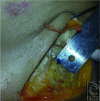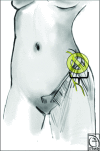Safe Tummy Tuck: Anatomy and Strategy to Avoid Injury to the Lateral Femoral Cutaneous Nerve During Abdominoplasty
- PMID: 26171094
- PMCID: PMC4473816
Safe Tummy Tuck: Anatomy and Strategy to Avoid Injury to the Lateral Femoral Cutaneous Nerve During Abdominoplasty
Abstract
Background: Abdominoplasty is one of the most common aesthetic procedures performed in the United States. While poor contour and unsatisfactory cosmetic result have been recognized, neuropathic pain from lateral femoral cutaneous nerve injury has been poorly described. We aim to improve outcomes by using an anatomical study to develop a strategy to avoid injury to the lateral femoral cutaneous nerve in abdominoplasty.
Methods: Twenty-three fresh cadaver abdomens were dissected to evaluate the course of the lateral femoral cutaneous nerve, using 2.5× loupe magnification. Measurements were taken from the nerve to the anterior superior iliac spine and from the pubic symphysis to the lateral femoral cutaneous nerve. Recordings of the relationship of the nerve to the inguinal ligament and depth at scarpa's fascia were also made. Statistical analysis was performed to find average distances with a standard deviation.
Results: On average, the distance from the lateral femoral cutaneous nerve to the anterior superior iliac spine was 3.62 (SD = 1.32) cm and 13.58 (SD = 2.41) cm from the pubic symphysis in line with the inguinal ligament. The lateral femoral cutaneous nerve was found at the inguinal ligament 80% of the time and 20% of the time superior to the ligament and always deep to scarpa's fascia.
Conclusion: Abdominoplasty carries a high patient and surgeon satisfaction rate. The plastic surgeon is continuously challenged to identify ways to improve outcomes, efficiency, and morbidity. Minimal and careful dissection in the area around 4 cm of the anterior superior iliac spine in addition to preserving scarpa's fascia near the inguinal ligament may serve as key strategies to avoiding lateral femoral cutaneous nerve injury.
Keywords: abdominoplasty; lateral femoral cutaneous nerve; plastic surgery; safety; tummy tuck.
Figures



References
-
- Ducic I, Zakaria HM, Felder JM, Arnspiger S. Abdominoplasty-related nerve injuries: systematic review and treatment options. Aesthet Surg J. 2014;34:284–97. - PubMed
-
- Hoyos AE, Perez ME, Castillo L. Dynamic definition mini-lipoabdominoplasty combining multilayer liposculpture, fat grafting, and muscular plication. Aesthet Surg J. 2013;33:545–60. - PubMed
-
- Levesque AY, Daniels MA, Polynice A. Outpatient lipoabdominoplasty: review of the literature and practical considerations for safe practice. Aesthet Surg J. 2013;33:1021–9. - PubMed
-
- Gmür RU, Banic A, Erni D. Is it safe to combine abdominoplasty with other dermolipectomy procedures to correct skin excess after weight loss? Ann Plast Surg. 2003;51:353–7. - PubMed
-
- Chaouat M, Levan P, Lalanne B, Buisson T, Nicolau P, Mimoun M. Abdominal dermolipectomies: early postoperative complications and long-term unfavorable results. Plast Reconstr Surg. 2000;106:1614–8. discussion 1619-23. - PubMed
LinkOut - more resources
Full Text Sources
